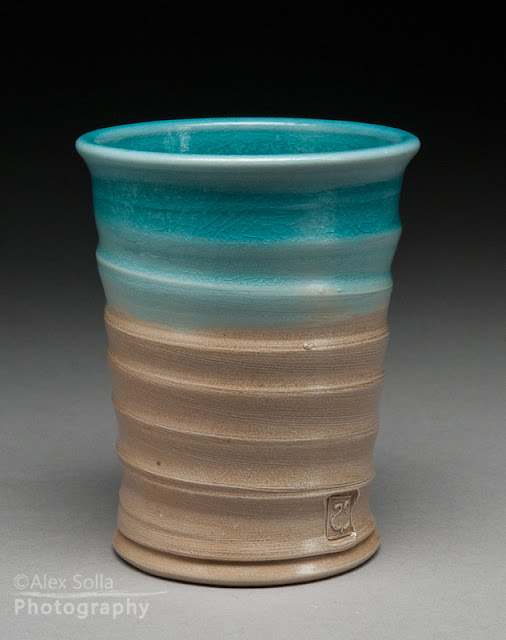This handbuilt mug was made as a demo for John Neely's beginning handbuilding class. During my third year at Utah State, I began teaching the beginner's handbuilding class. Having spent the bulk of 15 years as a strictly wheel throwing potter, this was quite a change for me. As a way of kick starting my teaching process, I had watched John Neely and Jason Hess as they taught their respective handbuilding classes for nearly two years.
This mug turned out nicely ovoid, with a very nice softened lip. The handle fits sweetly into the hand. The texture and the edge finishing was all done through a bed sheet laid on the soft slab. It is a perfect example of knowing what can be done to the clay at the early soft stages. The seam was beveled while the clay was still wet, allowing the whole form to be completed in one session. For students just beginning to work in soft slabs, this was eye opening. For me... it was the start of me thinking about clay very differently.
One of the most interesting aspects of being in a large graduate program was the exposure to so many different style of working, including many MANY different claybodies. John Neely had been working on a couple different woodfired claybodies that had wondefully bizarre names like Pioneer Day. Usually there was some play on words (or holidays as the case may be), and usually referred to some component of the claybody. Many of these claybodies were designed for a specific type of work or firing style: ie, reduction cool, woodfiring in the Train Kiln, or the salt kiln.
In my second year, I spent the bulk of the year experimenting with glazed surfaces in the salt and soda kilns. I had been trying to find a white stoneware body which would give me some clay body color other than grey in the salt kiln. I wanted a dense white tight clay body which would allow my glazes to show up bright and strong. John made many suggestions and eventually I created this particular body, which used Helmer Kaolin as one of the primary clay components. It was buttery smooth when throwing, took handles well, was very dense when fired. All in all, it was a nice claybody. When I showed my students the claybody, with the forms all flipped over so they could see the wadding marks and flashing on the bottoms of the pots, one student made a comment about the flesh colored quality of the claybody... saying that the bowl looked very flesh, almost breast-like. I chuckled and named the claybody: Neely's Nipple. Mind you, I didn't advertise the claybody this way. But when I saw other students mixing up the claybody later on, I had to laugh just a little.




2 comments:
Beautiful! You always surprise me with the glazes you use...would you mind telling me what kind of glaze is the one on the Neely's Nipple cup? It's exquisite!
Absolutely happy to share my glazes. You'll laugh. This stunning turquoise is nothing more than a VERY standard cone 10 Oribe, fired in the salt kiln. The inside bottom of the tumbler is the very typical dark green Oribe color, but where it got hit hard by the sodium, it is a much more turquoise color. VERY fun to play with "standard" glazes we all know and use in normal reduction firings... and then seeing how they behave (or dont!) in the salt kilns.
Post a Comment